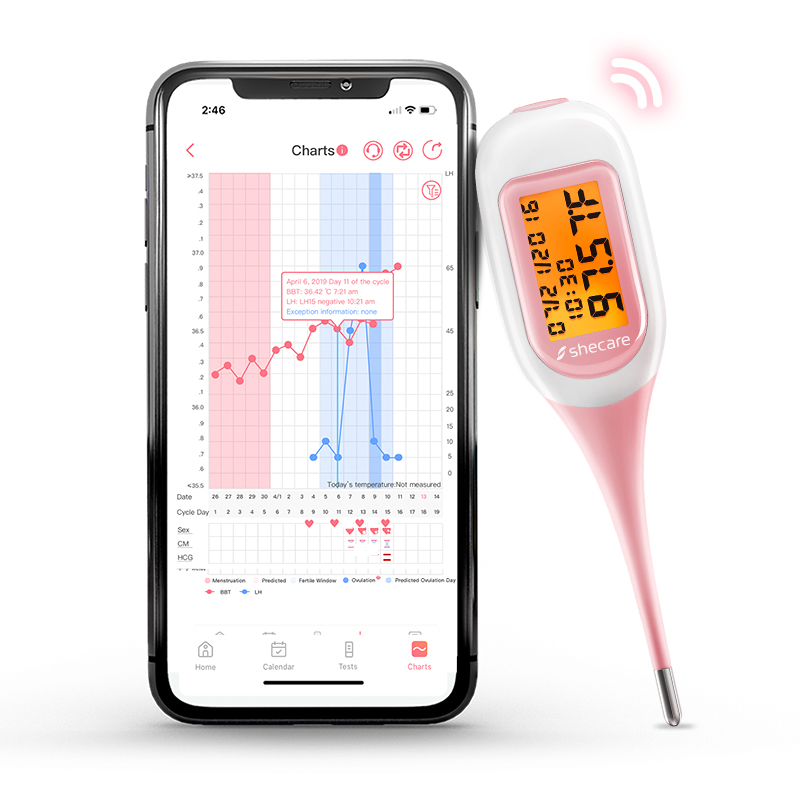Smart basal thermometers are advanced tools designed to help women track their basal body temperature (BBT) accurately and conveniently. By monitoring subtle changes in BBT, women can gain insights into their menstrual cycle, ovulation, and fertility. In this guide, we will provide step-by-step instructions on how to use a smart basal thermometer effectively, including how to check your basal body temperature, how to take your BBT, and whether a basal thermometer can be used to detect fever.
A basal thermometer is used to measure basal body temperature (BBT), which is the body's lowest resting temperature, typically measured immediately after waking up and before any physical activity. This measurement is crucial for tracking ovulation cycles in women, as BBT slightly rises during ovulation due to hormonal changes. Here are some key uses of a basal thermometer:
Fertility Tracking: Women can use a basal thermometer to monitor their menstrual cycle and identify their most fertile days. By charting daily BBT readings, they can predict ovulation and increase the chances of conception.
Natural Family Planning: Couples who prefer natural methods of contraception can use BBT readings to determine when to abstain from intercourse or use other protective measures.
Detecting Pregnancy: A sustained elevated BBT for more than 18 days post-ovulation can indicate pregnancy.
Identifying Hormonal Imbalances: Regular BBT tracking can help detect irregularities in the menstrual cycle, which may suggest hormonal imbalances or thyroid issues.

Checking your basal body temperature involves taking your body temperature upon waking up in the morning, even before getting out of bed or engaging in any physical activity. This is because BBT represents the lowest body temperature during a 24-hour period, which is influenced by hormonal fluctuations associated with the menstrual cycle.
Make sure your smart basal thermometer is ready for use and within reach.
Set a consistent time to take your BBT each morning, preferably around the same time to maintain accuracy.
Ensure you have had a minimum of three to four hours of uninterrupted sleep before taking your temperature.
Upon waking up, reach for your smart basal thermometer and turn it on if required.
Position the thermometer correctly, either under your tongue or against a specific measurement site indicated by the manufacturer.
Wait for the thermometer to provide a signal indicating that the temperature has been successfully measured.
Record the temperature reading in a designated fertility tracking app or a dedicated BBT chart.
Taking your basal body temperature correctly is essential to obtain accurate and reliable readings. Follow these steps to ensure precise measurements:
Make sure your basal body thermometer with app is clean and free from any debris.
Take the thermometer in hand and position it for measurement, as indicated by the manufacturer's instructions.
Place the thermometer under your tongue or at the designated measurement site.
Keep your mouth closed and breathe naturally through your nose during the measurement process.
Wait for the thermometer to complete the measurement, typically indicated by a signal or beep.
Remove the thermometer from your mouth or measurement site and check the displayed temperature.
While smart basal thermometers are highly accurate in measuring basal body temperature, they are not designed for detecting fevers. Basal thermometers are specifically calibrated to capture small temperature changes that occur during the menstrual cycle. Fever detection requires thermometers that are specifically designed and calibrated to measure higher body temperatures associated with fever.
If you suspect you have a fever, it is recommended to use a general-purpose digital thermometer that has been approved for fever detection. These thermometers are typically designed to measure a wider range of temperatures and provide more accurate readings for fever detection.
Smart basal thermometers are powerful tools for tracking basal body temperature, enabling women to gain insights into their menstrual cycles and fertility. By following the instructions outlined in this guide, including how to check your basal body temperature, how to take accurate measurements, and understanding the limitations of basal thermometers in detecting fevers, you can effectively utilize a smart basal thermometer for fertility tracking and family planning purposes.